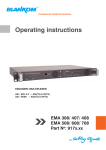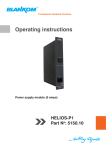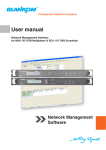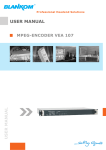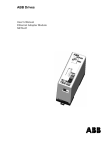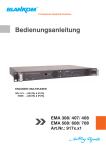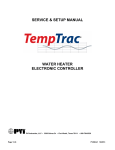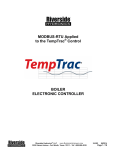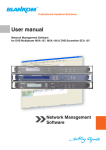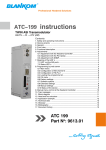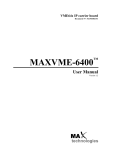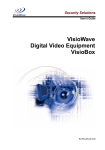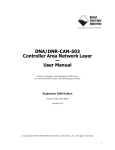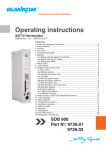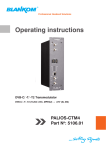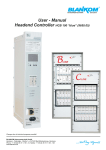Download u s e r m a n u a l user manual mpeg
Transcript
Professional Headend Solutions USER MANUAL USER MANUAL MPEG-ENCODER / MULTIPLEXER EMA 207 MPEG-ENCODER / MULTIPLEXER EMA 207 (9172.81) Manual Rev. 01 (2008) BLANKOM Antennentechnik GmbH/ Subject to modifications Content list 1. Installing and operating instructions .........................................................................................................1 1.1 Safety instructions ...................................................................................................................................1 1.2 Contact ....................................................................................................................................................1 1.3 General description of functions ..............................................................................................................2 1.4 Multiplexer / Re-multiplexer / PID filter ....................................................................................................2 2. Explanation of the functional elements......................................................................................................3 2.1 Front view ................................................................................................................................................3 2.2 Rear view.................................................................................................................................................4 2.2.1 Input and output ports .....................................................................................................................4 2.2.2 Further function and control elements.............................................................................................4 3. Operating instructions .................................................................................................................................5 3.1 Commissioning of the EMA 207 (EASY, without configuration)..............................................................5 3.2 Basic settings on delivery (Factory settings) ...........................................................................................5 3.3 Configurations via the Ethernet interface ................................................................................................5 3.3.1 Network connection to the computer...............................................................................................6 3.3.2 Configuration menu (HTML page)...................................................................................................6 3.3.2.1 Status information / Help functions .........................................................................................7 3.3.2.2 Settable parameters for the EMA 207 .....................................................................................8 3.3.2.2.1 General Input Selection...................................................................................................8 3.3.2.2.2 Ethernet Interface............................................................................................................9 3.3.2.2.3 Channel MUX (Settings for the transport stream)...........................................................9 3.3.2.2.4 ASI Main Input...............................................................................................................11 3.3.2.2.5 Encoder (Input-A ... D) ..................................................................................................11 3.3.2.2.6 System parameters .......................................................................................................13 3.3.3 Detailed configuration (for single and multiple device systems) ...................................................14 3.3.3.1 The 1-device system ........................................................................................................14 3.3.3.2 The multiple device system (commissioning cascades) ..................................................14 3.3.4 Transport Stream bit rate (TS out bitrate), system bitrate.............................................................17 3.4 Extended configuration, individual settings ...........................................................................................18 3.4.1 TTX Processing / VPS / WSS .......................................................................................................18 3.4.2 SDI signal interface .......................................................................................................................19 3.4.3 Options ..........................................................................................................................................19 3.4.4 Firmware updates (emergency program)......................................................................................19 3.4.5 Re-set to status on delivery (Factory setting)................................................................................20 3.4.6 Integration into the headend management system for B-LINE or C-LINE ....................................21 MPEG-ENCODER / MULTIPLEXER EMA 207 (9172.81) Manual Rev. 01 (2008) BLANKOM Antennentechnik GmbH, Germany / Subject to modifications 4. Appendix .....................................................................................................................................................22 4.1 Technical data .......................................................................................................................................22 4.2 Accessories ...........................................................................................................................................24 4.2.1 Accessories as standard ...............................................................................................................24 4.2.2 Optional accessories .....................................................................................................................24 4.3 Glossary and abbreviations ...................................................................................................................25 MPEG-ENCODER / MULTIPLEXER EMA 207 (9172.81) Manual Rev. 01 (2008) BLANKOM Antennentechnik GmbH, Germany /Subject to modifications 1. Installing and operating instructions 1.1 Safety instructions • When assembling and commissioning the EMA 207 and executing the settings, always follow the accompanying instructions exactly. • The devices are not to be assembled and brought into use by anybody who is not an authorised technician. • When components are being installed in areas where reception is important, ensure that EMC regulations are observed. • All assembly, installation and cable connection must take place when no electricity has been connected. • The provisions of DIN EN 50083 must be observed at all times when working with the equipment. In particular, DIN EN 50083/1 regarding safety may on no account be ignored. • The devices come under protection classification I. It is absolutely necessary, therefore, to insert the mains plug into a fused socket. • Warning Connecting external video sources of which the mass has a different potential from that of the EMA 207 may cause “wow” (avoided by matching the potentials or isolating them from each other). 1.2 Contact If there are any questions or problems, help is available from: BLANKOM Antennentechnik GmbH Hermann-Petersilge-Str. 1 07422 Bad Blankenburg Germany Telephone: Fax: +49 (0) 3 67 41 / 60-0 +49 (0) 3 67 41 / 60-100 Email: Web: [email protected] www.blankom.de MPEG-ENCODER / MULTIPLEXER EMA 207 (9172.81) Manual Rev. 01 (2008) BLANKOM Antennentechnik GmbH, Germany / Subject to modifications 1 1.3 General description of functions The EMA 207 with “cascade” facility is an MPEG-Encoder and Transport Stream Multiplexer. With it, the user’s own digital programme “bouquets” can be produced; also, pre-existing programmes. They are transmitted as a DVB-compatible MPEG transport stream in the ASI format. This signal can be broadcast or fed into the cable TV network with the aid of appropriate modulators. The EMA 207 encodes both analogue AV signals and digital AV signals (SDI, uncompressed) into an MPEG2 Transport Stream. Up to four input signals are encoded at each device and inserted into the output transport stream. The output signal is a DVB transport stream as per ISO13818-1 at a maximum data rate of 214 Mbps and is transmitted via the ASI interface. It can be sent either to a cascaded EMA 207 or to a downstream modulator. By cascading EMA 207 devices (up to 14), a transport stream with up to 56 services can be produced or these services can be added to an incoming transport stream. The EMA 207 ASI input port copes with a transport stream signal at a maximum rate of 214 Mbps. With adequate transmission rate on the part of the external transport stream, the internal encoded AV signals can be embedded in accordance with the DVB standard using the multiplexer integrated into the EMA 207. The output signal contains all the tables necessary to the programme and associated services (PAT, PMT and SDT). An NIT will be generated but will not contain any network-specific information. A downstream modulator is responsible for the necessary adaptation of the NIT. 1.4 Multiplexer / Re-multiplexer / PID filter A multiplexer has been integrated into the EMA 207 for processing the incoming transport stream. On condition that in this transport stream (requiring forwarding) an adequate transmission rate is available, or additional transport volume is achievable by raising the transport stream bit rate, new services and/or programme components can be added. Depending on the configuration of the 4 input interfaces, the analogue or digital AV signals (SDI) will be converted into DVB data and pooled to a standard DVB signal or added to the DVB transport stream being forwarded. The parameters necessary for the input interfaces and the transport stream parameters have been pre-set at the factory (see Section 3.2). See Section 3.3.3 for details of how EMA 207 cascade systems using multiple devices are brought into use and how the transport stream can be manipulated from the HTML user interface. 2 MPEG-ENCODER / MULTIPLEXER EMA 207 (9172.81) Manual Rev. 01 (2008) BLANKOM Antennentechnik GmbH, Germany / Subject to modifications 2. Explanation of the functional elements 2.1 Front view Fig. 1: EMA 207, front view POWER (green) LED illuminated Device switched on System (green) LED illuminated Internal system components ready for operation LED flashing Wrong parameter chosen / configuration error recognised LED not illuminated Internal fault INPUT VIDEO A, B, C, D (yellow) LED not illuminated Input port deactivated LED flashing No standard video signal recognised at the input port LED illuminated Video signal recognised at the input port INPUT TS (yellow) LED not illuminated Input port deactivated LED flashing ASI signal not recognised at the input port LED illuminated ASI signal recognised at the input port MPEG-ENCODER / MULTIPLEXER EMA 207 (9172.81) Manual Rev. 01 (2008) BLANKOM Antennentechnik GmbH, Germany / Subject to modifications 3 2.2 Rear view Fig. 2: EMA 207, rear view Factory set 2.2.1 Input and output ports VIDEO A, B, C, D Video input port, FBAS / SDI (configurable) AUDIO A, B, C, D Audio input port, analogue ASI IN DVB Transport Stream input port ASI OUT DVB Transport Stream output port NET Ethernet interface, network connection point (device control, etc.) RS232 Serial connection (firmware update, restoration of delivery status) The audio input ports are symmetrical. If they are used asymmetrically, Pin 1 and 3 must be allocated as signal lines and Pin 4,5 and 2 as return lines (shielding). Mono Not in use Dual Channel B Stereo Pin Pin 3 (+) 1 (+) 5 (-) 4 (-) Stereo Dual Mono Left Channel Mono Channel A signal Right channel Pin 2 = Shielding (6 to 8 not used) Fig. 3: Pole allocation, audio socket 2.2.2 Further function and control elements Mains connection block Fuse, switch, low temperature outlet earth screw For potential equalisation FACTORY SET Resetting to delivery status (see Section 3.4.5) 4 MPEG-ENCODER / MULTIPLEXER EMA 207 (9172.81) Manual Rev. 01 (2008) BLANKOM Antennentechnik GmbH, Germany / Subject to modifications 3. Operating instructions 3.1 Commissioning of the EMA 207 (EASY, without configuration) NB All assembly and connection work must take place when no electricity has been connected. On no account may the safety notes (see Section 1.1) be ignored. The device is intended to be installed on sliding rails in a 19-inch rack. Contact must be made for the video, audio and ASI signals at the appropriate connection points on the rear of the device using appropriate cables. As soon as all the wiring has been done for the signal, the the power supply can be connected and the device switched on. The operating status is shown by the LEDs on the front panel. Warning. When more than one device is being used ensure that identical network parameters have been set in all of them as the delivery status. Before multiple devices can be linked into a network, they must be given individual IP addresses (see Section 3.3.2.2.2). They should first be connected to the PC and have differentiated IP addresses set (see Section 3.3.1). Ask the network administrator for an IP address space. 3.2 Basic settings on delivery (Factory settings) The EMA 207 is delivered with optimal configuration for 4 AV channels. At the ASI output port a transport stream is produced with a bit rate of 38 Mbps into which the data of the 4 input signals will be included. The “ASI Main Input” is activated. All programme details and Transport Stream information are neutral and can be adapted to match the requirements of the cable network operator. To change the configuration, the HTML user interface is provided via the Ethernet interface (see Section 3.3). The basic settings of the EMA 207 are shown in the following list: Encoder Input CVBS FBAS (PAL), analogue audio ASI Main Input ON ASI input port is activated DHCP OFF The set IP address will be used IP Address 192.168.2.86 default IP address IP Net Mask 255.255.255.0 TS OUT bit rate 38,000 kbps System bit rate 6,000 Kbps Table 1: Basic settings Range: 1 000 – 214 000 kbps Bandwidth for each input channel (encoder) The delivery status can be restored via “Factory setting” at any time (see Section 3.4.5). 3.3 Configurations via the Ethernet interface If it is necessary to change the basic configuration or to create a cascade of more than one EMA 207 to create a DVB Transport Stream (see Fig 12), the particular HTML user interface must be called up on a computer connected to the device(s). All the settings can be made via Internet Browser. How the user interface works is almost self-explanatory. Any special features of use will be explained in the following chapters. MPEG-ENCODER / MULTIPLEXER EMA 207 (9172.81) Manual Rev. 01 (2008) BLANKOM Antennentechnik GmbH, Germany / Subject to modifications 5 3.3.1 Network connection to the computer System requirements: • PC/laptop with an Ethernet interface 10/100 Mbps • Internet browser (such as Windows Internet Explorer, Mozilla Firefox or similar) Making the connections: The PC and the EMA 207 must be connected to the network using an Ethernet cable. If the EMA 207 is connected directly to the PC, a cross-link Ethernet cable must be used. To establish the connection, the IP addresses of the devices must first be matched up. That of the EMA 207 is 192.168.2.86 on delivery. The address of the network connection in the PC must be adapted to the IP address of the EMA 207 (subnet mask: 255.255.255.0, IP address: 192.168.2.XXX). Do not let XXX be exactly the same as the IP address of the EMA 207. When cascades are being configured initially, it is necessary to ensure that there is always only one EMA 207 connected to the network, as the IP addresses of all the devices are identical on delivery. Once the IP addresses have been individualised, all the devices can be connected to the network. When the IP address for the device has been entered into the address field of the browser, a connection will be made to the relevant device and the appropriate log-in window will be displayed: Fig. 4: Log-in window serial number: Here, the 5-digit serial number of the device is entered. This number can be found on the rear of the device and is repeated at various points in the device documentation on a label. These labels should be stuck to the device where they can be seen once it has been installed, or should be used for the documentation of the equipment as a whole. Doing this will make access much easier later. password: Access to the configuration menu is password protected. On delivery, the password is: neu. If the password or the IP address are unknown or have been forgotten, pressing the FACTORY SET key on the rear of the device will return the details to what they were on delivery (see Section 3.4.5.). The device will then have access and basic settings as described above. Any setting which has already been individualised, will, of course, be lost. 3.3.2 Configuration menu (HTML page) The configuration menu will appear on successful log-in. It is divided into two sections, explained in detail below. Section 1 covers status information and help functions: Change password, Help, Factory setting, Set Date & Time and Status xxx (when activated) Section 2 contains the settings for the parameters: st nd rd th General Input Selection, Ethernet Interface, Channel MUX, ASI Main Input, Encoder (1 , 2 , 3 and 4 Input A ... D), Sys(tem) – Parameters, Load and Save (Softkey). Please note: items selected from the “General Input Selection” menu require certain fields to be completed in the subsequent menu. If the selection is altered, the details so far must be saved (with Save), so that the relevant fields are actually adjusted. 6 MPEG-ENCODER / MULTIPLEXER EMA 207 (9172.81) Manual Rev. 01 (2008) BLANKOM Antennentechnik GmbH, Germany / Subject to modifications 3.3.2.1 Status information / Help functions 1 2 3 4 Fig. 5: Web Interface, Status information / Help functions (Section 1) (1) Status 19x: The status pages regularly deliver updated internal information for maintenance checks on the status and functioning of the device. For example, the status 190 reported the actual input status. (2) Change password: The password for the access to the configuration menus consists of a maximum of 8 characters. Permitted characters: any lowercase or uppercase letter, any figure, but no symbols and no umlauts. On delivery, the password is: neu. (3) Factory setting (Softkey): Using this key returns all parameters to the values they had on delivery. The procedure takes approximately 10 seconds. During this period, no transport stream signal is available at the ASI output port. However, this function will not return to the factory setting the IP address which has been set. Factory set (see 3.4.5) by means of the key on the rear of the device returns the IP address to 192.168.2.86 and the password to neu. (4) Help: online help, call-up of the help pages in German (Hilfe) or English (short instructions). MPEG-ENCODER / MULTIPLEXER EMA 207 (9172.81) Manual Rev. 01 (2008) BLANKOM Antennentechnik GmbH, Germany / Subject to modifications 7 3.3.2.2 Settable parameters for the EMA 207 (Anything pre-set under “Factory Setting” will be underlined in the display.) 3.3.2.2.1 General Input Selection 6 7 Fig. 6: Selection of types of input signal This is the area in which the expected audio and video signal norms are allocated to the input ports. Options: If any input ports are switched off in the configuration as delivered or if any input components are not installed, a grey field with the text “Channel OFF” will be displayed; this cannot be altered. (6) Encoder A ... D: Here, the type of operation which is desired for each channel can be selected by clicking through the list. ''Channel OFF'': No data is reaching the multiplexer via the channel. ''Composite (CVBS)'': in this case, analogue signals are expected for both video and audio. ''SDI, embedded Audio'': Here, the input signal is serial digital video (SMPTE 259M-C, 270 MHz) with integrated audio (AESEBU, 48 KHz) and possibly with video text (WST/PAL). (For details, see Section 3.4.2) ''SDI, analogue Audio'': SDI processing, possibly with video text, together with analogue audio input (For details, see Section 3.4.2) (7) ASI Main Input: ''OFF'': there will be no processing of data from this input port ''Mux with Intern'': When this is displayed, the transport stream from the ASI input port is multiplexed to a shared stream with the date from the internal sources. This port is primarily intended for the cascading of a number of devices, but can also process other, “outside”, streams. If it is used for this, great care must be taken to avoid overlaps with the SID/PID. N.b., in this mode, no editing or mapping is possible. 8 MPEG-ENCODER / MULTIPLEXER EMA 207 (9172.81) Manual Rev. 01 (2008) BLANKOM Antennentechnik GmbH, Germany / Subject to modifications 3.3.2.2.2 Ethernet Interface 9 10 11 Fig. 7: Settings for the Ethernet interface with the network (9) Use DHCP: [ON/OFF] (Allocation of the IP address, default, e.g.: 192.168.2.86 "ON": once only, on start-up, an IP address will be requested via a DHCP server. If the request elicits no response, the preset IP address will be used. "OFF": the preset IP address will be used. (10) IP Address: [0.0.0.0 ... 192.168.2.86 ... 255.255.255.255] This is a sample IP address in case "use DHCP" is signalled as OFF, or it has been impossible to contact a DHCP server. (11) IP subnet mask: [0.0.0.0 ... 255.255.255.0 ... 255.255.255.255] This is the mask allocated to the IP address. 3.3.2.2.3 Channel MUX (Settings for the transport stream) 14 15 16 17 18 19 20 21 23 22 24 Fig. 8: Parameter settings for the configuration of the transport stream (14) ASI Output Mode: [Continuous / Burst / Loop] An ASI transport data packet consists in 188 or 204 payload bytes. Continuous mode: Payload bytes are continuously transmitted alternating with “sync words” (K28.5). The bit rate is dictated by the interval between the payload bytes. This interval is dictated by the number of “sync words”. The maximum bit rate possible with this type of output is 98 Mbps. MPEG-ENCODER / MULTIPLEXER EMA 207 (9172.81) Manual Rev. 01 (2008) BLANKOM Antennentechnik GmbH, Germany / Subject to modifications 9 Burst mode: In this mode, all the payload bytes in a packet are sent at a frequency of 27 MHz in one burst (without “sync words”), then the “sync words” follow. The number of sync words dictates the interval between the data packets, which then gives the bit rate. The maximum bit rate possible in this case is 214 Mbps. Loop IN -> OUT: Here the input signal is looped to the output. The length of the packet at the output port is always 188 bytes in this mode. Please note: One sometimes meets different definitions of the expressions “Continuous Mode” and “Burst Mode” but the technical content is basically the same. See Section 4.3. (15) Bytes per packet: [188/204] Here, 188 or 204 can be set, but not for LOOP. (16) TS Out Bit Rate: [1,000 ... 214,000] The output bit rate can be 1,000 ... 214,000 kbps. It must be selected in association with the ASI output mode (see also point 14 above and Section 3.3.4) (17) TS-ID: [1 ... 65,535] (Transport stream identifier) This detail is how the transponder identifies the transport stream generated. All devices in a cascaded system must use the same TS-ID. (18) Provider name: [Provider] The programme provider can insert a name here for the transport stream that has been formed. The name for any particular TS-ID should be the same in all devices in a cascaded system. The length of the name is limited to 16 characters. (19) Create NIT: [OFF, dummy, Cable, Satellite, Terrestrial] dummy: The multiplexer creates an empty NIT (network information table) as place-holder, and this table will be filled in by the succeeding device, if any; a QAM modulator, for example. Cable, Satellite, Terrestrial: The NIT is produced with the appropriate specification but without any details of frequency. OFF: In this case, no NIT is generated. (20) Create TDT/TOT: [OFF, ON] With the help of the internal real-time clock and the “local time offset” (see point 39), the tables for time are generated here. The clock will keep going when the EMA 207 is switched off. (21) Network ID: [1 ... 100 ... 65 535] Unique identifier for the network. For instance, number of the cable network. The network ID of all transport streams generated in a network should be the same. (22) Original Network ID: [1 ... 65 535] When programmes or transponders are being forwarded, the origin of the data can be indicated here by inserting the “original” network ID for purposes of information. (23) Cascade number within network: [1 ... 8] The number of the cascade is inserted here to distinguish between the EMA 207 cascades installed. It must be the same number for all the EMA 207s of a cascade and it serves to generate unique programme numbers (designated by ServiceID) within a network. 10 MPEG-ENCODER / MULTIPLEXER EMA 207 (9172.81) Manual Rev. 01 (2008) BLANKOM Antennentechnik GmbH, Germany / Subject to modifications (24) Device within cascade: [1 ... 14] The number of the device within the cascade is inserted here to distinguish between the EMA 207s installed within the cascade. The number must be different for all the EMA 207s of this cascade and it serves to generate unique programme numbers (designated by ServiceID) and PIDs within a transport stream. The order in which the devices are wired is of no significance for the numbering. 3.3.2.2.4 ASI Main Input 25 Fig. 9: electrical adapter at the ASI input port (25) Cable Equalizer: [OFF, ON] It is possible to set up an equaliser at the input port if long lengths of cable are being used. 3.3.2.2.5 Encoder (Input-A ... D) (All the following setting notes apply equally to encoders 1 … 4.) 26 27 28 29 30 31 32 35 + 36 (available only for SDI embedded Audio) 33 34 Fig. 10: Setting of encoder parameters for the individual input channels (26) Programme name: This is where a programme name is allocated for each encoder input port. The programme name will be displayed by the set-top box. The programme name must be unique and may appear only once in a cascade of encoders. The maximum length is 16 characters. (27) Programme language: [deu, eng ...] identifies the language for the audio data stream and teletext. It should be designated as per ISO 639-2. (28) Video system: [PAL/ SECAM (50 Hz), NTSC (60 Hz), OFF (Digital Radio)] These options set the type of video signal being accommodated. If PAL is the type, there are the variants B, G, H, I, N; this and SECAM operate at 50 Hz. NTSC in the M version operates at 60 Hz. In the “OFF” setting, the video signal is ignored and a digital radio channel is generated. MPEG-ENCODER / MULTIPLEXER EMA 207 (9172.81) Manual Rev. 01 (2008) BLANKOM Antennentechnik GmbH, Germany / Subject to modifications 11 (29) System bit rate: [1,000 ... 6,000 ... 15,000 kbps] Here the bandwidth is established for audio, video and table data in the relevant encoder. The value is only an upper limit. The bit rate actually generated will be slightly slower and will not be absolutely constant. Warning: The sum of all the bit rates (from bandwidth for channels) and the bit rate (the bandwidth) of the “ASI Main Input” used must be less than 90% of the “TS Out bit rate”, otherwise data transfer cannot be guaranteed. (30) Audio bit rate: [64 ... 320 ... 384 kbps] This determines the audio data bit rate. It is an element of the system bit rate. (31) Audio mode: [Stereo,Joint Stereo, Dual Channel, Mono, use VPS] Here the type of audio data is identified. "use VPS": here the identification transferred within the VPS signal is taken over into the MPEG data stream as audio header. Additional condition applying to “use VPS”: TTX Processing = Video IN and VPS-WSS = VPS or VPS+WSS (32) Video format: [4:3, 16:9, use WSS] This is how the means of interpreting the video input signal for the MPEG header is established. In respect of "use WSS", only the "16:9 Fullformat" is evaluated. Anything else will be transmitted as 4:3. For this it is a condition that TTX is set at "Video IN". (33) TTX processing: [OFF, Video IN, Intern (ViTex)] Video IN: Here teletext from the video input signal is changed into data packets conforming to DVB and is transmitted in the transport stream. Intern: At this point, using special additional software (ViTex), it is possible to administer an internal video text carousel and transmit it in the transport stream. OFF: No teletext will be generated. (34) VPS-WSS: [OFF, VPS, WSS, VPS+WSS] VPS and/or WSS lines in the video input signal will be converted into data packets conforming to DVB and transmitted in the transport stream. For this it is a condition that TTX is set at "Video IN". (35) Audio Channel Pair: [1/2 ... 15/16] When SDI with embedded audio is being transmitted, the audio channel pair to be used for the transmission can be selected here (see Section 3.4.2). (36) Audio Input Level: [+6 ... 0 ... -20 dB] This is for adaptation to the audio level at the encoder input port. The 0 dB setting is equivalent to an input level of 6 dBu. Here are some examples: If the level is 12 dBu, „6“ must be entered to obtain +6 dB, and, similarly, if the level is -14 dBu, „-20“ must be entered for –20 dB. 12 MPEG-ENCODER / MULTIPLEXER EMA 207 (9172.81) Manual Rev. 01 (2008) BLANKOM Antennentechnik GmbH, Germany / Subject to modifications 3.3.2.2.6 System parameters 39 37 38 Fig. 11: System settings for video text and real time (37) Video Lines with TTX: [0xFF87] The lines used for the video text carousel being internally administered can be determined here in the vertical blanking interval (VBI) of the video signal, the areas from line 7 to 22 and 320 to 335. The setting is bit by bit: “1” means “use”, “0” means “don’t use”. The entries are hexadecimal; line 7 is equivalent to 0x8000, line 22 to 0x0001. The standard line use is equivalent to the setting 0xFF87: st 8 9 10 11 12 13 14 15 16 17 18 19 20 21 22 TV line, 1 - 7 nd 2 half of 320 321 322 323 324 325 326 327 328 329 330 331 332 333 334 335 the picture Binary 1 1 1 1 1 1 1 Hex, 0x... F F Table 2: configuration of the line use for video text 1 1 0 0 0 8 0 1 1 1 7 Notes: Lines 16 to 19 and 329 to 332 usually exclude teletext (kept as test lines). “0x” as a prefix indicates hexadecimal figures. A calculator can be used for the calculation of the hex figure, for instance the calculator in Windows. For the [Bin] element, the binary values 0 and 1 are entered in the desired order. When the display is switched over to hexadecimal [Hex], the hexadecimal result will appear. (38) Status Pages in ViTex-TTX: If the device is being used to manage its own videotext, status pages will be transmitted for service purposes, giving current system states and messages, using pages 190 … 199. When the setting is “OFF”, all the status pages but page 199 are suppressed. This page range is available for conventional teletext tasks. (39) Local Time Offset (to UTC): This is the difference between local time and “Coordinated Universal Time”, e.g. Germany = 1). Audio Frames per PES Block (1 to 8): Although the standard allows 1 to 8 frames, this range is not supported from every connectable audio device with an ASI TS input port known to BLANKOM. This, with an inappropriate combination of frame value and audio bitrate, can lead to sound problems (for example, periodic breaks). With this menu item, it is now possible to adapt the BLANKOM device to accommodate the one connected. All “audio only” devices tested so far will work reliably with the setting “1” or “2”; devices for digital video and audio signals (ASI TS) require the setting “4”. Audio input impedance: Depending on need, the impedance of the symmetrical audio input ports can be selected as 600 ohms or 10 kilo-ohms. Whichever is selected will always apply for all inputs to the device. MPEG-ENCODER / MULTIPLEXER EMA 207 (9172.81) Manual Rev. 01 (2008) BLANKOM Antennentechnik GmbH, Germany / Subject to modifications 13 3.3.3 Detailed configuration (for single and multiple device systems) Depending on the job in hand and the desired number of channels per DVB transport stream, the devices can be operated individually or in groups (cascades) of up to 14 devices. 3.3.3.1 The 1-device system This is the configuration on delivery. Possible detailed configuration options are: IP address the one pre-set is 192.168.2.86 IP subnet mask the one pre-set is 255.255.255.0 TS-ID the 5-figure serial number is entered as default Provider name the default entry is “Provider” Network ID the default entry is “100” Programme name the default settings are „Prog-A“ ... “Prog-D” System bit rate the default entry is 6,000 kbps TS Out bit rate the default entry is 38,000 kbps All the setting options can be found in Section 3.3.2 or on the on-line (Internet) help page. The default is 4 channels with standard figures for the system bit rate. It is possible to change these pre-set bit rates as long as the set “TS Out bit rate” is taken into consideration (see Section 3.3.4). 3.3.3.2 The multiple device system (commissioning cascades) The fact that the EMA 207 can be cascaded means that multi-device systems can be created so that DVB transport streams exist for up to 56 services. Multi-device systems have to be used if more than 4 new services (this means TV programmes with their additional information) have to be combined into a transport stream or added to one. If this is done, changes need to be made to the set parameters for all devices from the HTML pages. Also, signal connections must be made (between ASI-OUT and ASI-IN) between the devices using 75-ohm BNC cables. (see Fig. 12). Data / Configuration (Ethernet) MPEG ENCODER / Multiplexer 1 Ethernet DVB Transport stream (max. 214 MBit/s) In 1 (AV / SDI) Signal 1 In 2 (AV / SDI) Signal 2 InSignal 3 (AV / SDI)3 InSignal 4 (AV / SDI)4 In 1 (AV / SDI) Signal 5 Signal 6 In 3 (AV / SDI) Signal 7 InSignal 4 (AV / SDI)8 In 2 (AV / SDI) (AV / SDI) (AV / SDI) (AV / SDI) (AV / SDI) (AV / SDI) (AV / SDI) (AV / SDI) (AV / SDI) In 1 (AV / SDI) Signal 9 (AV / SDI) Signal 10 (AV / SDI) In 3 (AV / SDI) Signal 11 (AV / SDI) In 4 (AV / SDI) Signal 12 (AV / SDI) In 2 (AV / SDI) ASI main Input A B C D MPEG ENCODER Multiplexer 2 Ethernet ASI out TS1 ASI in A B C D MPEG ENCODER Multiplexer 3 Ethernet ASI out TS2 ASI in A B C D ASI out TS3 QAM-Modulator QAM Upconverter Upconverter Fig. 12: Circuit diagram of a triple cascade (additionally with an external transport stream) 14 MPEG-ENCODER / MULTIPLEXER EMA 207 (9172.81) Manual Rev. 01 (2008) BLANKOM Antennentechnik GmbH, Germany / Subject to modifications Every device is capable of adding 4 new programmes (services) to the existing DVB transport stream as long as there is enough transport stream capacity or extendibility. If devices have been completely individualised in their basic settings, each new service would be added as a transponder in its own right. To ensure the newly added services belong together, it is possible to link up to 14 devices in a logical order to become a single cascade. In this way each of the newly added services is allocated to a transponder. The following settings must be identical for every device in a cascade, in order to ensure generation of a unique transport stream: Transport stream identification (TS-ID) Unique identification of the transport stream generated. The TS-ID can be any number between 1 and 65 535. However, at the start the TS ID will be the 5digit serial number of the EMA 207 being initialised. In the simplest case, the TS-ID of the first device should also be entered for all the devices. IMPORTANT In cable networks each TS-ID is allowed to appear only once. For this reason, neither the different transport streams generated by means of the (possibly cascaded) EMA 207 nor the transport streams from other programme providers may have the same transport stream ID. The TS IDs of transport streams already existing in the cable must be known in this context. Cascade within network: All devices belonging to a cascade within a single network (a headend) have to be designated with the same cascade number. Network ID: This identifies the distribution network (the headend); all transport streams generated or processed in a headend are given the same network ID. The following settings must be unique to the relevant device or will be taken account of by only one device in the cascade. IP address: The IP address of each device must be unique within the IP network. Device within cascade: Within a cascade of a maximum of 14 devices, each device must receive a unique ID [1 … 14]. The serial order due to the ASI cabling is quite irrelevant. Create NIT: If a blank Network Information Table is created for a device during configuration, the device configured to receive it will overwrite with the current values all NIT information contained in the transport stream. If this option is configured in more than one device, it will be the table in the last device which is functional. Create TDT/TOT: see above. If TDT or TOT tables are created for a device during configuration, the device configured to receive it will overwrite with the current values all the relevant information contained in the transport stream. If this option is configured in more than one device, it will be the table in the last device which is functional. Programme name: The programme name is the designation of the service taken over via the relevant interface, A to D. If more than one device is in use, the default setting for each device will automatically generate the programme name “Prog A” … “Prog D”. These names will show in the programme tables of the reception devices. They should be unequivocal in meaning and should therefore be changed to represent the actual situation. The information on cascades and positions which has been set in the configuration will be the basis for the distribution of the transport stream over the individual programmes (or services) and of the automatic allocation of neutral programme names and of AV PIDs and service IDs in ascending order. It is possible to change the programme names but not the PIDs. MPEG-ENCODER / MULTIPLEXER EMA 207 (9172.81) Manual Rev. 01 (2008) BLANKOM Antennentechnik GmbH, Germany / Subject to modifications 15 Automatically allocated Service-IDs and PIDs Device/No. Input port EMA 207/1 2) Service PMT Video Audio TTX A Prog-A 0x10 0x110 0x210 0x310 0x410 0x414 1) B Prog-B 0x11 0x111 0x211 0x311 0x411 0x414 1) C Prog-C 0x12 0x112 0x212 0x312 0x412 0x414 1) D Prog-D 0x13 0x113 0x213 0x313 0x413 0x414 1) A Prog-A 0x20 0x120 0x220 0x320 0x420 0x424 1) B Prog-B 0x21 0x121 0x221 0x321 0x421 0x424 1) C Prog-C 0x22 0x122 0x222 0x322 0x422 0x424 1) D Prog-D 0x23 0x123 0x223 0x323 0x423 0x424 1) A Prog-A 0x30 0x130 0x230 0x330 0x430 0x434 1) B Prog-B 0x31 0x131 0x231 0x331 0x431 0x434 1) C Prog-C 0x32 0x132 0x232 0x332 0x432 0x434 1) D Prog-D 0x33 0x133 0x233 0x333 0x433 0x434 1) A Prog-A 0x40 0x140 0x240 0x340 0x440 0x444 1) B Prog-B 0x41 0x141 0x241 0x341 0x441 0x444 1) C Prog-C 0x42 0x142 0x242 0x342 0x442 0x444 1) D Prog-D 0x43 0x143 0x243 0x343 0x443 0x444 1) … … … … … … … … EMA 207/14 A Prog-A 0xE0 0x1E0 0x2E0 0x3E0 0x4E0 0x4E4 1) B Prog-B 0xE1 0x1E1 0x2E1 0x3E1 0x4E1 0x4E4 1) C Prog-C 0xE2 0x1E2 0x2E2 0x3E2 0x4E2 0x4E4 1) D Prog-D 0xE3 0x1E3 0x2E3 0x3E3 0x4E3 0x4E4 1) EMA 207/2 EMA 207/3 EMA 207/4 VTX 1) Programme name … Table 3: Automatically allocated service IDs and PIDs 1) VTX: Videotext internally generated. The EMA 207 has the facility that a teletext carousel can be generated for each particular device. This teletext can be allocated to one or all of the services being shown. This is an optional function and a charge is made for it. 2) TTX: Videotext of the external signal at the video IN ports A … D 16 MPEG-ENCODER / MULTIPLEXER EMA 207 (9172.81) Manual Rev. 01 (2008) BLANKOM Antennentechnik GmbH, Germany / Subject to modifications Note • The SID/PID for the slots configured (the programmes and channels) is automatically allocated according to a fixed pattern. Inserting details of the device in the cascade and the number of the cascade ensures that the values will not overlap. If “outside” transport streams are being processed at the ASI input port, care must be taken to ensure that if the SID/PIDs of any external and internal programme streams overlap, the internal programme streams have priority. Any “external” programme streams with the same names will be blocked at a filter and not fed into the output port. Operating several cascades within a network (a headend) To get unique service IDs if there are several cascades in one headend, an offset is automatically added for the parameter “cascade number within network” (CNr): Cascade No. 1 2 3 4 5 6 Offset 0 0x04 0x08 0x0C 0x80 0x84 Table 4: Offset for the service IDs if several cascades are operated in a network 7 8 0x88 0x8C 3.3.4 Transport Stream bit rate (TS out bit rate), system bit rate The transport stream bit rate at the ASI output port can be set in the range between 1,024 kbps and 214 Mbps (for continuous mode, the maximum is 98 Mbps), with steps of 1 kbps. The output bit rate can be selected independently of the input bit rate at the ASI input port. However, care must be taken to ensure that the entire volume of data is transmitted, including the DVB channels generated additionally by the EMA 207. It should be noted that the transport stream at the ASI input may contain components with a fluctuating data rate. When estimating the bandwidth which will be necessary for the transmission of newly generated programmes, this should be borne in mind. The bit rate (“TS-Out Bit Rate”) is selected in the configuration settings under Channel Mux. For the EMA 207, the maximum TS-Out bit rate possible is 214 Mbps. When deciding the TS-Out bit rate it is necessary and important to check what is the maximum transport stream bit rate which can be processed or forwarded by succeeding components such as modulators and upconverters. The bandwidth (bit rate) which is available can be distributed across the channels generated by the EMA 207 in any proportions desired. Whenever individual settings are made, care should be taken to ensure that the figures entered into the configuration mask make sense. The notes in the following sections should be observed in this respect. Configuration of the system bit rates and “TS-Out bit rate”, the output bit rate When delivered and if reset is carried out with firmware, the system bit rates of each channel will be set to 6 Mbps. This setting should be seen simply as an upper limit and can be varied according to the content of the data being transmitted. It is possible to adjust the figures for each channel according to need. The “TSOut Bit Rate”, which is the data output rate, is preset to 38 Mbps, which gives enough scope for reliable operation as long as the “ASI Main Input”, the input port, is deactivated. The output rate must be decided in relation to the content being added, with a safety margin of at least 10 per cent, since it is not possible definitely to exclude swings in the data rate taking it over the upper limit. MPEG-ENCODER / MULTIPLEXER EMA 207 (9172.81) Manual Rev. 01 (2008) BLANKOM Antennentechnik GmbH, Germany / Subject to modifications 17 Examples of estimation of the “TS-Out bit rate”, the output bit rate Example 1: Single device with 4 encoders ASI Main Input = „OFF“ The encoder input ports A ... D employ the following system bit rates: 3x 6 Mbps and 1x 10 Mbps, making 28 Mbps in all This allocation, including the necessary 10% reserve for safety, gives a figure of 31 Mbps (minimum) to be set as the data output rate at the output port. Example 2: Single device with 4 encoders and an ASI Main Input ASI Main Input = „MUX with intern“ Here the incoming data stream has a bit rate of 50 Mbps, and 36 Mbps are used for the transport of the data. !4 Mbps are filled with “empty packets”. The encoder input ports A ... D employ the following system bit rates: 3x 4 Mbps and 2x 8 Mbps, making 24 Mbps in all 36+24=60, plus 10% safety margin, so that the data output rate at the output port is 66 Mbps (minimum). 3.4 Extended configuration, individual settings The configurations explained so far suffice for the intended use of the EMA 207 to generate transport streams in conformity with DVB. There are further options possible for professional use with special functions. 3.4.1 TTX Processing / VPS / WSS These configuration settings control how teletext information contained in the analogue signal will be adopted and the VPS and WSS control signals will be captured, processed and forwarded in the Transport Stream. The following settings and functions are possible: Switches State Function TTX processing OFF No teletext or VPS and WSS data adopted VPS-WSS Any TTX processing Video IN VPS-WSS OFF TTX processing Video IN VPS-WSS VPS WSS VPS+WSS The teletext data contained in lines 7 to 22 and 320 to 335 are digitalised and transmitted in the DVB transport stream Teletext data from lines 7 to 22 and 320 to 335, will digitalised and transmitted in the DVB transport stream. In addition, VPS, WSS or VPS+WSS (depending on what has been selected) will be digitalised and then transmitted as part of the DVB transport stream. Table 5: Configuration for processing of teletext, WSS and VPS 18 MPEG-ENCODER / MULTIPLEXER EMA 207 (9172.81) Manual Rev. 01 (2008) BLANKOM Antennentechnik GmbH, Germany / Subject to modifications 3.4.2 SDI signal interface The encoder input ports can be configured to process SDI input signals. A mixture (SDI / CVBS) of different configurations for the 4 input components is possible. The operational fields in the configuration menu will be offered for each channel as appropriate to the configuration (see 3.3.2.2.1). The following signal components can be processed: SDI video signals with accompanying analogue sound signal: Here the signal processing is as for FBAS with an analogue sound signal. SDI video signals with embedded digital sound signal (this is known as embedded audio) In this case, there are additional configuration options available for the processing of the audio signal: Audio Input Level: Audio Channel Pair: Setting of the audio level (see 3.3.2.2.5) Selection of stereo pair An SDI signal may contain a number of stereo sound channels carrying different signals. The EMA 207 can select any pair of signals from these and embed them in the DVB transport stream. 3.4.3 Options The EMA 207 can access the signals when processed in a variety of ways. If there is a need for further functions, it is always possible to enquire about them (Section 1.2, contact). Adaptations or options supplied to customer specifications may be charged for. 3.4.4 Firmware updates (emergency program) Fig.13: Update window If a firmware update becomes necessary, a Windows update programme will be made available. The update will be carried out either via the Ethernet interface or via the (RS232) control interface on the EMA 207. For this purpose the computer and the EMA 207 must be connected to each other by means of either an Ethernet cable or a null modem cable (cross-linked cables in each case). After the program has been opened, the computer interface to be used must be selected in the update window. If the right interface is selected, the “Upload” button will be activated, allowing the update to be started with this button. Firmware updates do not change any parameters already set (whereas the opposite is true of using the recessed “Factory setting” key, which restores settings to what they were on delivery of the device). MPEG-ENCODER / MULTIPLEXER EMA 207 (9172.81) Manual Rev. 01 (2008) BLANKOM Antennentechnik GmbH, Germany / Subject to modifications 19 3.4.5 Re-set to status on delivery (Factory setting) The following 3 possible ways of restoring the status on delivery: Version 1: Factory setting using the user software (HTML page) This will only be possible if the IP configuration for the device is known, including network address subnet mask, and the device can be contacted via the Ethernet interface. The Internet browser should be used as described in Section 3.3.2 (“Connecting the network to the computer”) to access the device operation system. When the access data have been entered, the configuration menu will appear. The “Factory Setting” box is displayed in the menu header. If this box is clicked, all the parameters for the device which are capable of configuration, excluding the IP address, will be reset to those for the state the device was delivered in, and the device will be restarted. Version 2: Factory setting using the "Factory Set" key (on rear of device): In order to re-set all configurable parameters including the IP address for the device so that they are as delivered, this key must be activated for at least 5 seconds, until all the LEDs on the front flash at the same time. The flashing LEDs are the confirmation that the Factory Set function has been carried out. When the key is released, a new start will follow automatically in which the parameters are as reset. If the connection with the device has become invalid because of the restoration of the original IP address, the steps indicated in Section 3.3.2, “Connecting the network to the computer” must be followed in order, after which access will again be possible. Version 3: Factory setting with the aid of the maintenance software (via RS 232): The maintenance software is a Windows PC program module obtainable from BLANKOM Antennentechnik GmbH which will create the factory settings. Firstly, the maintenance software has to be installed on the control PC and a cable connection must be established between this and the EMA 207. The cable must be a null-modem cable. When the program has been started and the various procedures run, the EMA 207 is restarted with all parameters reset. When the second or third versions are used, the IP address of the EMA 207 after the re-start will be: of the EMA 207 after the re-start will be: 192.168.2.86 with the net mask 255.255.255.0. 20 MPEG-ENCODER / MULTIPLEXER EMA 207 (9172.81) Manual Rev. 01 (2008) BLANKOM Antennentechnik GmbH, Germany / Subject to modifications 3.4.6 Integration into the headend management system for B-LINE or C-LINE If a EMA 207 is being used in association with B- or C-LINE headend components, the possibility exists (using HCB100 „BLUE“, from 9650.03 upwards) of integrating the encoder into the overview of the headend and calling it up from this screen. A hub will be necessary in this case, through which the Ethernet connections of the HCB100 and the EMA 207 are networked. Before this happens, the “lowest” of the IP addresses of all the EMA 207 encoders must be entered in the configuration menu for the IP address of the HCB100. It is only possible to enter (or change) IP addresses into the HCB 100 directly. This cannot be done from the html user interface. Warning: If multiple EMA 207s are being integrated, it is important to note that the HCB 100 will search in the network for any IP address (N) with the “lowest” value and will then search for nine more with ever “higher” addresses (N+1...N+9). In consequence, the maximum number of EMA 207s which can be included in the headend overview of an HCB100 is ten. Switching on or re-setting the HCB 100 will cause any EMA 207 in the network to be read and shown in the overview along with the rest of the system. By clicking “Edit” (this word means “change” in German), a link is made to the IP address of the EMA 207 and the login window opens. Once the “serial number” and the “password” have been entered, the EMA 207 can be further configured as described in Section 3.3.3. Fig. 14: User interface: HCB 100 headend overview MPEG-ENCODER / MULTIPLEXER EMA 207 (9172.81) Manual Rev. 01 (2008) BLANKOM Antennentechnik GmbH, Germany / Subject to modifications 21 4. Appendix 4.1 Technical data Device Casing, dimensions for installation 19” rack, 1 height unit (steel sheet), HxWxD = 44 x 444 x 300 mm Operating voltage 85 ... 264 V~, 50/60 Hz or 110 ... 370 V- Power taken up 15 VA Weight approx. 4,500 g Video Encoder Standards PAL/SECAM (50 Hz), NTSC (M, 60 Hz) Compression MPEG-2 (MP@ML) Format 720 x 576 pixels System bit rate 1,024 ... 15,000 kbps, settable for each individual channel (or slot), depending on the total bandwidth and the number of channels Audio Encoder Compression MPEG-1, layer 2 Sampling frequency 48 kHz, stereo Bit rate 64 ... 384 kbps Transport Stream output port Protocol DVB-ASI, choice between burst and continuous mode TS data packet length Choice between 188 and 204 bytes Connection BNC, 75 ohms, 800 mVpp Bit rate 1 ... 214 Mbps in burst mode, 1 ... 98 Mbps in continuous mode - settable in steps of 1 kbps Channels 1 ... 4 encoder channels per individual device Transport Stream input port (input in the case of a multi-device configuration) Protocol DVB-ASI, choice between burst and continuous mode, 188 or 204 bytes (will adapt of itself) Connection BNC, 75 ohms, 800 mVpp Bit rate 98 or max. 214 Mbps (continuous or burst mode, respectively) 22 MPEG-ENCODER / MULTIPLEXER EMA 207 (9172.81) Manual Rev. 01 (2008) BLANKOM Antennentechnik GmbH, Germany / Subject to modifications AV input ports Video IN 4x BNC / 75 ohms analogue: PAL/SECAM (50 Hz), NTSC (60 Hz), 1 Vpp digital: SDI, 270 Mbps (SMPTE 259M-C), 800 mVpp, audio embedded (AES/EBU, 48 kHz) (any analogue audio is fed in through “Audio IN”) Audio IN 4x sockets as per EN50083-5 appendix B (no control functions) Choice between 600 ohms and 10 kilo-ohms, symmetrical, (mono, stereo, dual) +6 dB ... -20 dB: settable in steps of 0.5 dB over the range +6 dB to -20 dB Remote control Settings, data Ethernet interface, UDP/IP Extensions Cascade system Up to 14 devices can be combined into a cascaded system to form a DVB transport stream using the ASI interface. A maximum of 8 cascades per network (i.e. per headend) is possible. Extra functions Teletext, VPS, WSS Transparent feed of teletext signals, conversion and onward transmission of VPS und WSS signals Options Teletext 200 pages (generated in the device) Optional 1,000 additional pages (extended memory) SNMP Coming soon Editable Service ID and PID Coming soon MPEG-ENCODER / MULTIPLEXER EMA 207 (9172.81) Manual Rev. 01 (2008) BLANKOM Antennentechnik GmbH, Germany / Subject to modifications 23 4.2 Accessories 4.2.1 Accessories as standard 1 1 2 1 1 1 4 1 3 1 device connection cable 19" installation set (4 bolts; 4 washers; 4 cage nuts) replacement T fuses 1A / 250V null modem cable; 3 m; 9 poles (2 sub D sockets) patch cable; cross-linked; 3 m; 8 poles (2 RJ45 plugs) BNC connecting cable; 0.34 m DIN plug connectors, 5 poles guarantee certificate copies of serial number with 5 digits (in the storage pocket of the device manual) operating manual (this document) 4.2.2 Optional accessories The optional accessories can be ordered individually as required. Purpose Plug connection Length Type Item no. Video and ASI connector cable BNC - BNC 0.34 m VVK 526 8025.26 1m VVK 540 8025.40 2m VVK 541 8025.41 3m VVK 542 8025.42 ... m* VVK 543 8025.43 1m VAK 537 8025.37 2m VAK 538 8025.38 3m VAK 539 8025.39 ... m* VAK 560 8025.60 1m ASK 545 8025.45 2m ASK 546 8025.46 3m ASK 547 8025.47 ... m* ASK 548 8025.48 0.2 m AAK 536 8025.36 1m AAK 564 8025.64 2m AAK 535 8025.35 3m AAK 566 8025.66 ... m* AAK 567 8025.67 2m NKW 200 0144 Length Type Item no. SV 050 0143 SV 081 0141 Video adapter cable Audio connector and control cable Audio adapter cable BNC cinch DIN 8-pole – DIN 8 pole DIN 5-pole. -2 x XLR sockets DIN 5-pole. -2 x Cinch Cable to connect apparatus to mains C13 (standard connector cable)CEE7/7 (Schuko-type angle plug) Purpose Plug connection Audio plugs DIN plug connector, 5 poles (for cable diameter 6 mm) DIN plug connector, 8 poles m* = length as specified by customer Further accessories are to be found in the BLANKOM Antennentechnik main catalogue 24 MPEG-ENCODER / MULTIPLEXER EMA 207 (9172.81) Manual Rev. 01 (2008) BLANKOM Antennentechnik GmbH, Germany / Subject to modifications 4.3 Glossary and abbreviations Term Meaning Notes ASI Asynchrones Serielles Interface Interface for DVB transport stream BNC connection, 75 ohms Audio bit rate Digital bandwidth for audio transmission, element of the system bit rate The higher the value the better the transmission quality, but it may (slightly) limit the video bit rate. Audio mode Options for the audio channels to be The relevant option is entered transmitted. The options are: stereo, joint (unchangeably) into the EMA 207 coding. It stereo, mono, dual channel, Use VPS. will be transmitted with the additional DVB information. Burst mode ASI TS mode: either 188 or 204 data bytes are sent as a bundle with no intervals between them, then “sync words” follow. Identical with the mode: contiguous, packed, packed space, packed timing, data packed, packed burst Continuous mode ASI TS mode: data bytes are continuously transmitted alternately with sync words at equal intervals. Identical with the mode: interleave, distributed, spread out, byte-space, byteburst, byte timing, equality, data byte DHCP Dynamic Host Configuration Protocol: enables networked devices to receive IP addresses automatically If there is no DHCP service available or DHCP is switched off, the (default) IP address which has been set will be used Input channels Audio or video signal input Analogue (video and audio separately),SDI (video with audio embedded or separate) IP address Network address for access to data and configuration (in case there is no DHCP service) Factory setting: 192.168.2.86 IP subnet mask Mask for detailed identification of the address in the network Factory setting: 255.255.255.0 Kbps Bit rate Kilobits per second (where 1 Kilo=1024) Load Reads out the parameter settings of the EMA 207 and shows them in the settings masks. The parameters can be viewed and altered. “Save” saves the edited parameters Mbps Bit rate Megabits per second. MIB Management Information Base The device-specific file (ME.mib) to serve the system via SNMP Network ID Network identification: this ID gives the unique identification for the link between DVB Transport Streams (TSs) and a particular (cable) network Within the network this ID is the same for all TSs. This is an element of the NIT and is usually overwritten by the succeeding modulator component. NIT Network Information Table: this is an important table for the transmission of channel parameters. The NIT supports, for example, the “seek” function in the DVB receivers so that a broadcaster is found. The EMA 207 is capable of setting up this table. A succeeding modulator component can add to it or overwrite it. MPEG-ENCODER / MULTIPLEXER EMA 207 (9172.81) Manual Rev. 01 (2008) BLANKOM Antennentechnik GmbH, Germany / Subject to modifications 25 Term Meaning Password Access to configuration via the IP network The password on delivery is set to: neu is password-protected Programme language This shows the programme language; the The details will be displayed in the receiver abbreviations to be used are those in ISO for the information of the watcher. 639-2 code, (i.e. “deu” for German) Programme name This is the name of the newly generated DVB programme. Every AV channel should be given a name. The name of the programme will be presented for selection in the table of broadcasters by the DVB receiver. RDS Radio Data System Additional digital information concerning analogue radio programmes, e.g. name of broadcaster, short details, special announcements. Save Saves the configuration values which have been set for the EMA 207 These parameters are read using “Load” and stored using “Save” SDI Serial Digital Interface for digital, uncompressed video signals 270 MBit/s, transmission via BNC cables, audio data can be embedded SDT Service Description Table This contains the programmes offered and relevant details of broadcaster Serial number The 5-digit device serial number This serial number is on the rear of the device (it will be needed for “login”) SNMP Simple Network Management Protocol An interface protocol allowing data exchange and device control via the network System bit rate The digital bandwidth available for an A/V The system bit rate for a channel is channel. composed of the video and audio shares combined. TS Transport Stream (a data signal in packeted form) The whole of the information necessary to enable transmission of digital signals. One Transport Stream can contain more than one programme, with audio, video, teletext and details. TS-ID Transport Stream Identification (unique designation of the Transport Stream) When devices are linked up in series for a shared Transport Stream, they must all use the same TS-ID. TS out bit rate Output data bit rate of the Transport Stream = digital bandwidth This rate must be adequate to the quantity of data. TTX processing Teletext processing and onward transmission Conversion of the teletext signal contained in the analogue signal into digital transport packets which are then transmitted in the DVB signal. Video format Video system Standards applying to the analogue video Factory setting: PAL/SECAM (50 Hz); input signals which require conversion alternatively, NTSC (60 Hz) or OFF (Digital Radio) can be selected VPS / WSS VPS (video programming system): this is the recording control for the video recorder. WSS (wide screen signalling): WSS format control for the TV itself 26 Notes Both these signal components are contained in the analogue TV signal. WSS = ON and VPS = ON: here the signal components are converted and transmitted in the DVB signal. MPEG-ENCODER / MULTIPLEXER EMA 207 (9172.81) Manual Rev. 01 (2008) BLANKOM Antennentechnik GmbH, Germany / Subject to modifications






























